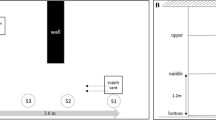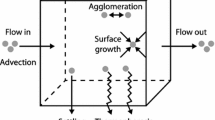Abstract
Experiments with dry, fluidized spores were conducted in a test apparatus to delineate the extent of spore contamination and deposition behavior under normal airflow conditions within a ventilation system. The surrogate biological warfare agent used in experiments was the spore-forming bacterium Bacillus atrophaeus. Viable-spore-counting methods were used in the study because they provide the most important number for estimating human health effects. Three common ventilation duct materials were evaluated: flexible plastic, galvanized steel, and internally insulated fiberglass. Transport efficiency ranged from 9 to 13% in steel and fiberglass ducts; transport efficiency was far less (0.1–4%) in plastic duct. Results showed that the deposition of surrogate biological warfare agent was significantly different in the three duct materials evaluated. All experimentally determined, dimensionless deposition velocities were in the range of theoretical predictions for dimensionless roughness, k +=10. All were 10–100 times greater than the velocities predicted for ducts with smoother surfaces, k +=0.1. For plastic duct, greater dimensionless deposition velocities were likely the result of charge forces between spores and surface. However, for the steel duct, a relatively large dimensionless deposition velocity was unexpected. These findings imply that building contamination will likely vary, depending on the specific type of duct material used throughout an affected area. Results of this study may aid in refining existing particle-transport models and remediation activities.
Similar content being viewed by others
Abbreviations
- ANOVA:
-
Analysis of variance
- APS:
-
Aerodynamic particle sizer
- B. anthracis :
-
Bacillus anthracis
- BG:
-
Bacillus globigii (B. atrophaeus)
- BWA:
-
Biological warfare agent
- C:
-
Coulomb
- CFU:
-
Colony forming unit
- C s :
-
Cunningham slip factor
- D :
-
Duct diameter
- d :
-
Particle diameter
- HEPA:
-
High-efficiency particulate air (filtration system)
- HVAC:
-
Heating, ventilating, and air conditioning (system)
- k + :
-
Dimensionless roughness
- L :
-
Duct length
- PB:
-
Phosphate buffer
- PBS:
-
Phosphate-buffered saline
- R e :
-
Reynolds number
- RH:
-
Relative humidity
- SD:
-
Standard deviation
- TSA:
-
Trypticase soy agar
- V d :
-
Particle deposition velocity
- U a :
-
Velocity in the duct
- η:
-
Kinematic viscosity
- u * :
-
Friction velocity
- ρ:
-
Particle density
- τ:
-
Particle relaxation time
- ν:
-
Viscosity
References
Atlas R.M. (2001). Bioterrorism before and after September 11. Crit. Rev. Microbiol. 27(4):335–379
Clesceri L.S., Greenberg A.E. and Trussell R.R. (eds). (1989). Standard Methods for the Examination of Water and Wastewater 17th edition. American Public Health Association, Washington DC
El-Shobokshy M.S. and Ismail I.A. (1979). Deposition of aerosol particles from turbulent flow onto rough pipe wall. Atmos Environ. 14: 297–304
Fan F-G. and Ahmadi G. (1995). A sublayer model for wall deposition of ellipsoidal particles in turbulent streams. J. Aerosol Sci. 5: 813–840
Fisk W. (1994). The California healthy buildings study. Center for Building Science News 7: 13
Fuchs N.A.: 1964, The Mechanics of Aerosols, in C.N. Davies (ed.), MacMillan: New York
Gilchrist M.J.R. (1992). Microbiological culturing of environmental and medical-device surfaces. In: Eisenberg H. (eds). Clinical Microbiology Procedures Handbook. American Society for Microbiology, Washington DC, pp. 4–11
http://www.svce.ac.in/∼ ∼msubbu/FM-WebBook/Unit-II/VelocityDistributionTurbulent.htm
Kowalski W.J. (2002). Immune Building Systems Technology. McGraw–Hill, New York, ISBN 0-07-140246-2
Lai A.C.K. and Nazaroff W.W. (2000). Modeling indoor particle deposition from turbulent flow onto smooth surfaces. J. Aerosol Sci. 31: 463–476
Matsumoto G. (2003). Anthrax powder: state of the art?. Science 302: 1492–1497
National Institute for Occupational Safety and Health (NIOSH): 2002, Guidance for protecting building environments from airborne chemical, biological, or radiological attacks, Department of Health and Human Services, Centers for Disease Control and Prevention, NIOSH Publication No. 2002–139; Cincinnati, OH
Raunemaa T., Kulmala M., Saari J., Olin M. and Kulamala M.H. (1989). Indoor air aerosol model transport indoors and deposition of fine and coarse particles. Aerosol Sci. Technol. 11: 11–25
Rose L., Jensen B., Peterson A., Banerjee S.N. and Arduino M.J.: 2004, Swab materials and Bacillus anthracis spore recovery from nonporous surfaces. Emerg. Infect. Dis. [serial on the Internet] 2004 June. http://www.cdc.gov/ncidod/EID/vol10no6/03–0716.htm
Sanderson WT, Hein MJ, Taylor L, Curwin BD, Kinnes GM, Seitz TA (2002). Surface sampling methods for Bacillus anthracis endospore contamination. Emerg Infect Dis. 8:1145–51
Schmel G.A. (1973). Particle eddy diffusivities and deposition velocities for isothermal flow and smooth surfaces. Aerosol Sci 4: 125–138
Seigel J.A. and Walker I.S. (2001). Deposition of biological aerosols on HAVC heat exchangers. Lawrence Berkley National Laboratory, LBNL-47476, Berkeley, CA
Sextro R.G., Lorenzetti D.M., Sohn M.D. and Thatcher T.L.: 2002, Modeling the spread of anthrax in buildings, Proceedings Indoor Air 2002 Conference, pp. 506–511
Sinclair J.D., Psota-Kelty L.A., Peins G.A. and Ibidunni A.O. (1992). Indoor/outdoor relationships of airborne ionic substances: comparison of electronic equipment room and factory environments. Atmos. Environ. 26A:871–882
Sippola M.R.: 2002, Particle deposition in ventilation ducts, Ph.D. dissertation, University of California, Berkeley, CA, LBNL-52189
Sippola M.R. and Nazaroff W.W. (2002). Particle deposition from turbulent flow: Review of published research and its applicability to ventilation ducts in commercial buildings. Lawrence Berkeley National Laboratory, LBNL-(51432), Berkeley, CA
Thacher T.L. and Layton D.W. (1995). Deposition, resuspension, and penetration of particles within a residence. Atmos. Environ 29: 1487–1497
Thacher T.L., Lai A.C.K. and Moreno-Jackson R. (2002). Effects of room furnishings and air speed on particle deposition rates indoors. Atmos. Environ. 36: 1811–1819
ThermoAndersen: Operator Manual: Viable Particle Sizing Sampler, ThermoAndersen, Smyrna, GA.
U.S. EPA: September 2002, Challenges faced during the Environmental Protection Agency’s response to anthrax and recommendations for enhancing response capabilities. A lessons learned report, prepared by the U. S. Environmental Protection Agency
Wallace L. (1996). Indoor particles: a review. J. Air Waste Manage. Assoc. 46: 98–126
Weis C.P., Intrepido A.J., Miller A.K., Cowin P.G., Durno M.A., Gebhardt J.S. and Bull R. (2003). Secondary aerosolization of viable Bacillus Anthracis spores in a contaminated US Senate Office. J. Am. Med. Assoc. 288: 2853–2858
Wood N.B. (1981). A simple method for the calculation of turbulent deposition to smooth and rough surfaces. J. Aerosol Sci. 12: 275–290
Acknowledgements
The authors wish to thank Don Schwartz, Joe Shinn, John Van Fossen, Souheil Ezzedine, and Kent Wilson. Work was performed under the auspices of the U.S. Department of Energy by Lawrence Livermore National Laboratory under Contract W-7405-ENG-48.
Author information
Authors and Affiliations
Corresponding author
Rights and permissions
About this article
Cite this article
Krauter, P., Biermann, A. & Larsen, L.D. Transport efficiency and deposition velocity of fluidized spores in ventilation ducts. Aerobiologia 21, 155–172 (2005). https://doi.org/10.1007/s10453-005-9001-z
Received:
Accepted:
Published:
Issue Date:
DOI: https://doi.org/10.1007/s10453-005-9001-z




